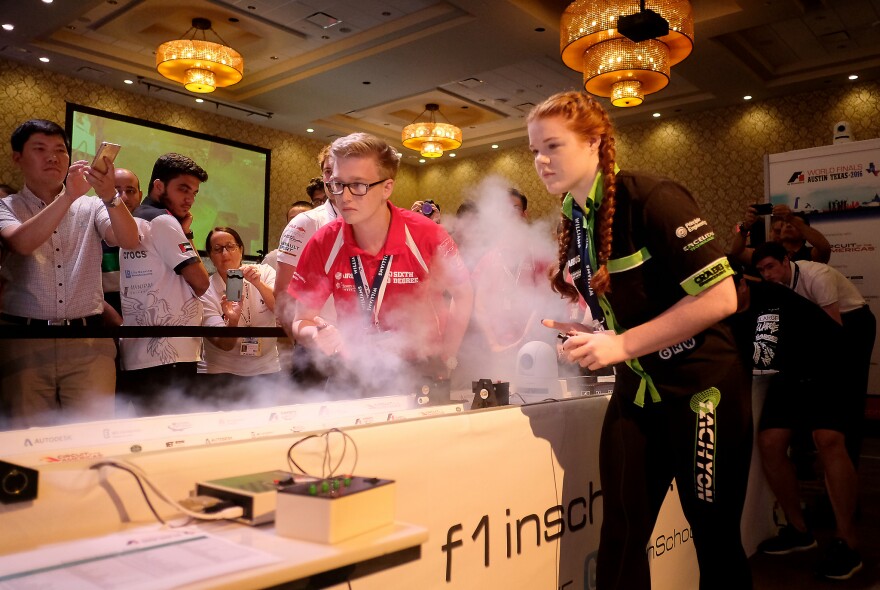New world race car champions were crowned in Austin this week and it was decided miles away from the Circuit of the Americas at the Hyatt Regency on Lady Bird Lake.
High school-aged kids from 23 countries came to Austin this week to compete in the F1 In Schools World Finals. The teens fabricated and engineered their miniature Formula One cars from scratch. Many of the students peering down the track to the finish are hoping this is just the beginning of their racing career.
“So, what we are is the biggest STEM competition in the world," said Andrew Denford, founder and chairman of F1 in Schools. "What we’ve done is created a challenge bringing all of those disciplines together, using the magnetic appeal of Formula One. So, basically we install this in the classroom and they can teach science, maths [sic] and technology and engineering in a fun and exciting way.”
He says this is a way to encourage the next generation of engineers and scientists. Just like Formula One, students work to make their car within a new set of specifications and rules released each year. And it’s not just the fastest car that wins.
“There’s a thousand points. The fastest car is 250," said Denford. "It helps if you have a fast car because that will probably mean it has passed scrutineering. It will probably mean it has been well-engineered, it’s got good aerodynamics. But of course, they judge you on pit display, portfolios and they judge you on the verbal presentation. So, it’s quite a big job.”
And for the teams that put it all together, a big prize awaits: mechanical engineering scholarships at City, University of London and University College London. Both schools have high-level motorsports engineering programs in the UK.
Denford came up with the idea of F1 in Schools years ago to sell more milling, lathing and routing machines, as well as 3-D printers. He owns a company that makes such things in the UK. The program has grown to the point where he has left the day-to-day care of his company to others and diverted much of his attention to this STEM education program.
Real-life racing teams are also looking to dip into this talent pool.
"The Formula 1 teams realize that we’ve got the best kids in the world here, so let’s not let them go slip through our fingers," said Denford. "Let’s give them an opportunity to get into the factory. Let’s give them jobs.”

Williams Martini Racing handpicked nine students to start their second class at the Ranstad Williams Engineering Academy.
“I’m looking for people who have a passion for engineering," said Pat Symonds, Chief Technical Officer of the Williams Formula One team. "People who can think laterally, people who are individualistic, yet can work in a team. And, if I see those things, I know I’ve got the engineer of the future.”
One American, Ajinkya Sawant of Team Mu in Marietta, Ga., is part of Williams Racing’s new class.
Just like F1, the in-school program is big abroad, but is just gearing up here in the states. There are more than 500 teams in Europe, but fewer than 60 are in the U.S. The person whose job it is to get the all of the Americas geared up: Austin’s Juan Gonzalez, a former assistant principal of Akins High School.
He says the program provides an opportunity to get students the skills needed in racing and for the rest of us.
“They would use computer aided drafting (CAD), computational fuel dynamics, computer aided machining and computer numerical control (CNC) mills and routers to produce it and so forth, plus the 21st century skills," said Gonzalez. "You’re talking about cars that are precision-machined to one-one thousandth of a tolerance. You’re getting into material sciences. You’re talking about working with composites: carbon fiber, your different plastics, ABS, delrin, acrylic, polycarbonates. You’re talking about your different metals from titanium to aluminum. So, this is really scaled up there."

In all, there were three teams from the U.S. among the 39 finalists. Perhaps none more unlikely than Harlem United coming all the way from Harlem, Mont. It’s a town of 3000 people located on mostly flat farmland. Most of the community either lives on or has roots in the Fort Belknap Indian Reservation located nearby. About as far from the glitz and glamor of Formula One as one can get. Yet somehow, the team managed to raise the 39 thousand dollars to get them down here for a week.
Senior Damon Adams originally got into computer aided drafting to design guitars. He joined the program as a sophomore at the urging of his teacher.
“I was able to do the CAD stuff," said Adams. "I had some experience in CAD programs before, so he asked me to be on the team so I could be the design engineer and design the car.”
Now he’s looking to become an engineer and, perhaps, move a little closer to COTA.
“Come to Texas A&M, maybe. Study mechanical engineering, maybe,” said Adams.
As for the speed competition, the fastest cars came down to two Greek teams, Aeolus Racing and Infinite Racing. Infinite Racing managed to win both heats with a time of 1.215 seconds and are the new F1 in Schools champs. Infinite Racing scored well-enough in the other three categories to take the F1 In Schools World Title back home to Greece.
This weekend, the professional F1 teams the students hope to be a part of one day take center stage at Circuit of the Americas.
Practice rounds start today. The U.S. Grand Prix will take place Sunday.





